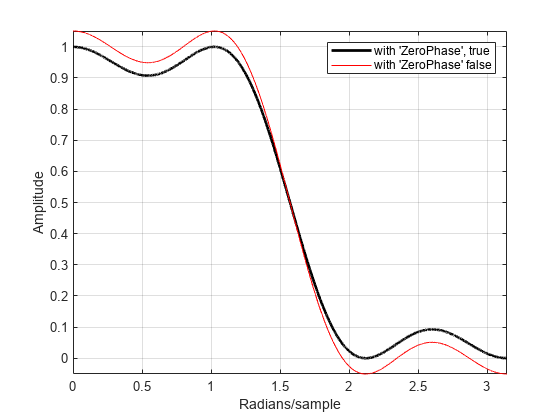fdesign.halfband
Halfband filter specification object
Syntax
d = fdesign.halfband
d = fdesign.halfband('type',type)
d = fdesign.halfband(spec)
d = fdesign.halfband(spec,specvalue1,specvalue2,...)
d = fdesign.halfband(specvalue1,specvalue2)
d = fdesign.halfband(...,fs)
d = fdesign.halfband(...,magunits)
Description
d = fdesign.halfband constructs
a halfband filter specification object d, applying
default values for the properties tw and ast.
Using fdesign.halfband along with design method
generates a System object™, if the 'SystemObject' flag
in the design method is set to true.
d = fdesign.halfband('type',type) initializes
the filter designer 'Type' property with type.
'type' must be either lowpass or highpass and
is not case sensitive.
d = fdesign.halfband( constructs
object spec)d and sets its 'Specification'
to spec. Entries in spec represent
various filter response features, such as the filter order, that govern
the filter design. Valid entries for spec are
shown below. These options are not case sensitive.
tw,ast(defaultspec)n,twnn,ast
where,
ast— attenuation in the stop band in decibels (the default units).n— filter order.tw— width of the transition region between the pass and stop bands. Specified in normalized frequency units.
By default, all frequency specifications are assumed to be in normalized frequency units. Moreover, all magnitude specifications are assumed to be in dB. Different specification types may have different design methods available.
The filter design methods that apply to a halfband filter specification
object change depending on the Specification choice.
Use designmethods to determine
which design method applies to an object and its specification choice.
Different filter design methods also have options that you can specify.
Use designopts with the design
method to see the available options. For example:
f=fdesign.halfband('N,TW');
designmethods(f)
d = fdesign.halfband(spec,specvalue1,specvalue2,...) constructs
an object d and sets its specifications at construction
time.
d = fdesign.halfband(specvalue1,specvalue2) constructs
an object d assuming the default Specification property tw,ast,
using the values you provide for the input arguments specvalue1 and specvalue2 for tw and ast.
d = fdesign.halfband(...,fs) adds
the argument fs, specified in Hz to define the
sampling frequency to use. In this case, all frequencies in the specifications
are in Hz as well.
d = fdesign.halfband(...,magunits) specifies
the units for any magnitude specification you provide in the input
arguments. magunits can be one of
linear— specify the magnitude in linear unitsdB— specify the magnitude in dB (decibels)squared— specify the magnitude in power units
When you omit the magunits argument, fdesign assumes
that all magnitudes are in decibels. Note that fdesign stores
all magnitude specifications in decibels (converting to decibels when
necessary) regardless of how you specify the magnitudes.
Examples
Version History
Introduced in R2011a
See Also
fdesign | fdesign.decimator | design | fdesign.interpolator | fdesign.nyquist | setspecs | zerophase

